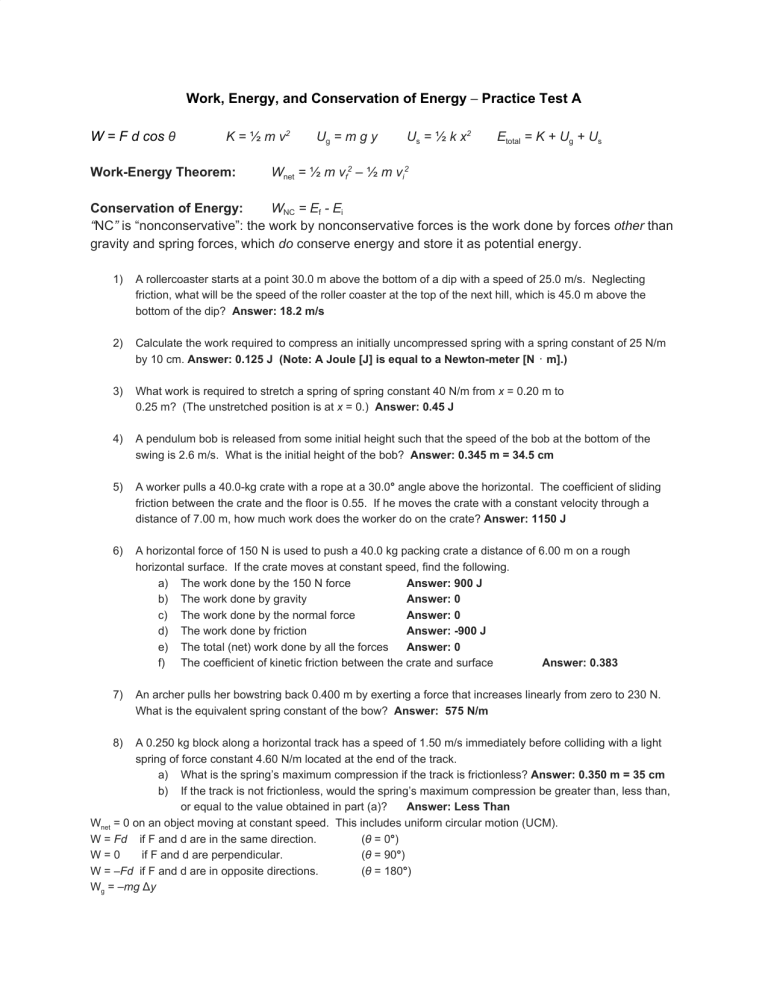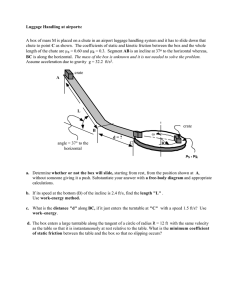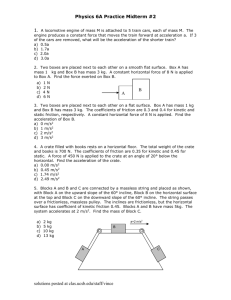
Work, Energy, and Conservation of Energy – Practice Test A W = F d cos θ K = ½ m v2 Work-Energy Theorem: Ug = m g y Us = ½ k x2 Etotal = K + Ug + Us Wnet = ½ m vf2 – ½ m vi2 Conservation of Energy: WNC = Ef - Ei “NC” is “nonconservative”: the work by nonconservative forces is the work done by forces other than gravity and spring forces, which do conserve energy and store it as potential energy. 1) A rollercoaster starts at a point 30.0 m above the bottom of a dip with a speed of 25.0 m/s. Neglecting friction, what will be the speed of the roller coaster at the top of the next hill, which is 45.0 m above the bottom of the dip? Answer: 18.2 m/s 2) Calculate the work required to compress an initially uncompressed spring with a spring constant of 25 N/m by 10 cm. Answer: 0.125 J (Note: A Joule [J] is equal to a Newton-meter [N ⋅ m].) 3) What work is required to stretch a spring of spring constant 40 N/m from x = 0.20 m to 0.25 m? (The unstretched position is at x = 0.) Answer: 0.45 J 4) A pendulum bob is released from some initial height such that the speed of the bob at the bottom of the swing is 2.6 m/s. What is the initial height of the bob? Answer: 0.345 m = 34.5 cm 5) A worker pulls a 40.0-kg crate with a rope at a 30.0° angle above the horizontal. The coefficient of sliding friction between the crate and the floor is 0.55. If he moves the crate with a constant velocity through a distance of 7.00 m, how much work does the worker do on the crate? Answer: 1150 J 6) A horizontal force of 150 N is used to push a 40.0 kg packing crate a distance of 6.00 m on a rough horizontal surface. If the crate moves at constant speed, find the following. a) The work done by the 150 N force Answer: 900 J b) The work done by gravity Answer: 0 c) The work done by the normal force Answer: 0 d) The work done by friction Answer: -900 J e) The total (net) work done by all the forces Answer: 0 f) The coefficient of kinetic friction between the crate and surface Answer: 0.383 7) An archer pulls her bowstring back 0.400 m by exerting a force that increases linearly from zero to 230 N. What is the equivalent spring constant of the bow? Answer: 575 N/m 8) A 0.250 kg block along a horizontal track has a speed of 1.50 m/s immediately before colliding with a light spring of force constant 4.60 N/m located at the end of the track. a) What is the spring’s maximum compression if the track is frictionless? Answer: 0.350 m = 35 cm b) If the track is not frictionless, would the spring’s maximum compression be greater than, less than, or equal to the value obtained in part (a)? Answer: Less Than Wnet = 0 on an object moving at constant speed. This includes uniform circular motion (UCM). W = Fd if F and d are in the same direction. (θ = 0°) W=0 if F and d are perpendicular. (θ = 90°) W = –Fd if F and d are in opposite directions. (θ = 180°) Wg = –mg Δy




